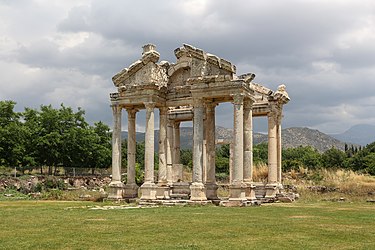Aphrodisias – The Gate Magazine – January 2001
In this article, Şerif Yenen describes Aphrodisias, the Place Where Love and Eternity Converge in Marble.
Aphrodisias: Where Love and Eternity Converge in Marble

Aphrodisias
“Imagine a city where a plethora of statues rolled about amidst broken columns, walls and excavated sites like so many stacked fish.” These words were uttered by Turkish archaeologist Kenan Erim years ago when he directed the excavation at Aphrodisias under the auspices of New York University. From the statues and ornate marble, visitors to Aphrodisias get the immediate impression it was a place where the art was given lofty status. The name Aphrodisias was derived from Aphrodite, the Greek Goddess of Love. This is one of several ancient cities named after the Goddess of Love. In order to erase paganism from the people’s minds, Christians changed the name Aphrodisias to Stravropolis. Later on, it took the name Caria and became the capital of the Carian province. During Ottoman times, it became the Turkish village of Geyre.
As there were marble quarries situated just a few kilometers away, Aphrodisias became famous as a center of sculpture as well as philosophy.
Statues bear sculptors’ signatures.
A determining feature of Aphrodisian scutpture were the signatures of local sculptors who from time to time were commissioned abroad; their names have been found on works erected in many Roman colonies. The finest examples are the two horsemen found at the Hadrian Villa in Tivoli and the Severus Victory Arch in Carthage. Sculpture contests were held in Aphrodisias and artists from other regions would take part in these competitions. A workshop found between the Consul building and the Temple of Aphrodite also attests to the importance afforded to sculpture. Many of the pieces uncovered during the Aphrodisias excavations are a myriad of decorations and reliefs along with statues of gods, heroes, emperors, orators, philosophers and boxers. Fine examples of Aphrodisian sculpture are displayed in the local Aphrodisias Museum and the Istanbul Museums of Archaeology.
The Ruins of Aphrodisias
Besides the notable statues lying in the courtyard and in the Aphrodisias Museum, here is a list of ‘must see’ edifices.
Tetrapylon: The monumental entrance located on the sacred road leading to the Temple of Aphrodite. A fine example of restored work.
Stadium: With a 30,000 seating capacity, this well-preserved stadiums was used for sports, concerts and dramatic events; gladiator tournaments were held in the eastern section.
Temple of Aphrodite: This Hellenistic era structure was converted into a church during the Byzantine era. Life was focused upon the Temple of Aphrodite; her cult was so entrenched that it took longer to convert Aphrodisians to Christianity than those in other regions.
Odeion: A semicircle building which was utilized as a type of theater.
The Hadrian Baths: With two large rooms on eitherside and the Caldarium in the center, it was built in the 2nd century A.D. during Hadrian’s reign.
Theater: The orchestra pit and stage building were renovated in the 2nd century A.D. for holding animal wrestling and gladiator tournaments. This Hellenistic era structure had a seating capacity of 8,000.




